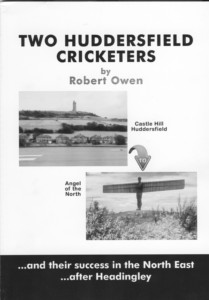Two Huddersfield Cricketers
Martin Chandler |Published: 2012
Pages: 80
Author: Owen, Robert
Publisher: Write Good Books
Rating: 4 stars

Back in 2009 I managed to find out from somewhere that the autobiography of Malcolm Scott had been published. I thoroughly enjoyed the book, and happily gave it a four star review. Three years later I learned that Scott’s collaborator, Robert Owen, had written this small book and I had no hesitation in buying a copy. For no particular reason it took me until very recently to pick the book up and read it. I feel a little embarrassed now that I don’t mention Owen at all in my review of A Geordie All-Rounder, as I realise now he must have been largely responsible for marshalling Scott’s thoughts in such masterful fashion.
Owen is from South Shields in the north east of England. Two Huddersfield Cricketers is, as the title suggests a study of the lives of two men who were born some way south of Tyneside, but who nonetheless both spent many years plying their cricketing trade there. Coincidentally Owen ended up making the opposite journey and living in Huddersfield. The two cricketers are Ron Aspinall and Alec Coxon. They had much in common in addition to Huddersfield. Both opened the bowling for Yorkshire after the Second World War and were useful lower order batsmen. Their figures are similar too – both took their wickets at just a tick over 20, and with the bat averaged just under 20.
The similarities continue. Both men left Yorkshire at the end of the 1950 season and both found their way to the area we now call Tyne and Wear where they served with distinction as professionals in the local league. There were differences to go with the similarities. Coxon stayed in his adopted home for the rest of his days, dying at 90 in 2006. After Aspinall’s playing career ended there were 22 years following, in the summer at least, the peripatetic lifestyle of a First Class umpire before he retired back to Huddersfield.
Despite their successes on the field both men had their disappointments in the First Class game. For Aspinall it was the fact that, ultimately, injury cost him his Yorkshire career and the possibility of England caps. He never regained full fitness after a serious Achilles tendon injury. Coxon did play for his country once, against Bradman’s Invincibles at Lord’s in 1948, a match England lost by 409 runs. There was an early wicket for Coxon as he dismissed Sid Barnes for a duck. Shortly afterwards he always believed he should have had Donald Bradman before he had scored. Sadly for him his bellicose appeal for lbw was turned down. The great man was later out for 38, so the rejection of Coxon’s appeal did not change the course of the match, but it probably did change the course of his career. After a defeat of such magnitude it was hardly surprising the selectors dropped a seam bowler. But it is difficult to imagine they would have dropped Coxon if he had dismissed both of Australia’s premier batsmen for nought.
The stories of the Two Huddersfield Cricketers are by their nature intertwined, and that is the way Owen writes his book. In eighty pages he has no difficulty in holding his reader’s attention, as the era and the personalities of his two subjects give him plenty of interesting material. Coxon in particular was a fearsome character, not dissimilar in approach to his successor Fred Trueman. Owen mentions one story I had heard before, but cannot sadly remember where. It surrounds the reason for Coxon leaving the First Class game, which was in part disillusionment at failing to make the Ashes touring party in 1950/51. But there were conduct issues too. Did he take a swing at Denis Compton at a festival match at the end of the 1950 season? Probably not it seems, but chapter and verse on that one unfortunately eluded Owen.
If I had to criticise Owen it would be on account of the brevity of his book. Cricket books have a tendency to be too long. Writers tend to overuse bland match accounts which amount to nothing more than padding. As indicated in Two Huddersfield Cricketers every single page is worth reading, and I find it difficult to believe Owen could not easily have managed another twenty or thirty pages without any lapse in quality. Is he, I wonder, a disciple of Walt Disney, and his exhortation to ‘always leave them wanting more’?
In my review of A Geordie All-Rounder I expressed some disappointment at the proof reading and the quality of the illustrations. In Two Huddersfield Cricketers I saw only one typo, the spelling of the name of the umpire who let Coxon down at Lord’s in ’48 and the photographs, of which there are quite a number are, given the limitations imposed by the type of paper used, very good. All in all it is an excellent read, which I am happy to recommend.






Leave a comment